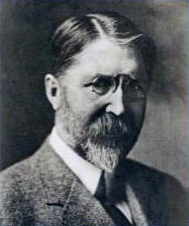
Charles Limbert (1854-1923) was as interested in the business of selling furniture as in advancing the ideals of the Arts & Crafts movement.
Limbert was born in Logansville, Pennsylvania, and grew up in Akron, Ohio. After a brief detour in the carriage trade, he followed his father into furniture sales. He began as a traveling salesman, working for different companies in the Midwest including Monk & Roberts and the John A. Colby Company. During this period, he met Philip Klingman, another salesman. The two agreed to represent each other’s wares, reducing the size of their territories. The agreement marks the beginning of an extended partnership and shows Limbert’s willingness to experiment with how he did business.
In 1889, Klingman and Limbert settled in Grand Rapids. By this time the city had established itself as a national center for furniture construction and sales. Home to numerous makers, it also hosted a semi-annual trade show. Leasing the Blodgett Building, the two men sublet the floors they didn’t use to out-of-town manufacturers. It was not just a novel solution for using unneeded space; it was also, as The Grand Rapids Press later described, the “origin of the furniture exposition building.” Real estate was not their primary pursuit; they established the Klingman & Limbert Chair Company. But their Victorian-styled furniture failed to find a customer base, and the venture proved short-lived, dissolving in 1892.
The failure of the Klingman & Limbert Chair Company freed Limbert to pursue his own goals. He founded the Charles P. Limbert furniture company in 1894 and spent the rest of the decade building it. During this period he was also president of the Heald Furniture Company and continued to sell the goods of other makers, including the outdoor furniture of the Old Hickory Company, a brand he would continue to sell even after his own company’s success. By the turn of the century, his reputation as a furniture salesman was well established–the April 1901 Furniture Record called him the “furniture commission man.” That skill earned him several prominent contracts, including the Patlind Hotel in Grand Rapids, the Grand Canyon Hotel, the Mission Inn (Riverside, CA), and the Old Faithful Inn in Yellowstone National Park.
As interest in Arts and Crafts furniture faded, Limbert shifted production to meet those tastes and successfully weathered the storms that would sink Stickley. Though later catalogs still featured some of Limbert’s most distinctive Arts and Crafts pieces, they shared the page with a variety of styles, including Chinese, Italian, Queen Anne, and William and Mary.
In 1921 Limbert suffered a stroke while traveling in Hawaii. He would never recover fully, and declining health prompted him to sell his shares in the company in September of 1922. He was dead less than a year later, leaving an estate of roughly $500,000 (worth about $6.5 million in 2011 dollars) to his sister and sole heir, Clara. In his obituary, The Grand Rapids Herald noted his reclusive character and his twin hobbies of gardening and raising chickens:
Of a retiring disposition, Mr. Limbert was in the public eye but little and found his pleasure in quiet pursuits. He was known as an exceptional fancier of flowering plants of which he collected many beautiful specimens from this and other countries. One of the delights, too, of his later years was the development of fancy breeds of poultry and his chicken pens always held some of the finest strains in the country.
He left behind a legacy of furniture design that alloyed a European sensibility with the rectilinear forms of the American Arts & Crafts Movement.
The company that bore his name survived Limbert’s death, but it could not survive the economic austerity imposed by World War II. It closed in 1944.

Pingback: Workshop Waffle 022 – shownotes | Trevor's Workshop